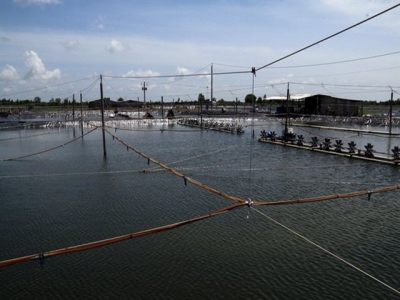Kiên Giang farmers increase harvests of aquatic species

KIÊN GIANG – The Cửu Long (Mekong) Delta province of Kiên Giang has harvested more than 130,000 tonnes of aquatic species so far this year, up 15 per cent from the same period last year, according to its Department of Agriculture and Rural Development.
Breeding white-legged shrimp in ponds whose beds are covered with plastic sheets in Kiên Giang Province’s Gò Quao District . – VNA/VNS Photo Lê Sen
The creatures include shrimp, mud crab, clam and fish, with shrimp accounting for 60,000 tonnes.
The province breeds brackish water shrimp in more than 125,650ha of ponds adopting extensive, semi-industrial and industrial farming.
More shrimp farmers have switched from traditional industrial farming methods to environment-friendly industrial farming.
They use anti-sunlight nets to cover their shrimp ponds, plastic sheets to cover the breeding pond beds and equipment to pump additional oxygen into the ponds.
Besides the breeding ponds, they also have others for treating wastewater.
Lê Việt Hải, who breeds shrimp in Gò Quao District’s Thủy Liễu Commune, has six ponds with a total area of 1,300sq.m and uses more than 10 ponds to treat wastewater in a closed cycle and the treated wastewater is used for breeding.
Under this model, shrimp get few diseases and are clean, the yields are high and the creatures fetch more than the market price.
His profit margin was 20 – 30 per cent, he revealed.
The province encourages farmers to breed shrimp to Vietnamese good agricultural practice (VietGAP) standards and international standards.
Aquaculture and rice are its two key economic sectors.
According to Mai An Nhịn, deputy chairman of the province People’s Committee, the agriculture sector has shifted to breeding aquatic species in areas where only one rice crop is grown a year and yields are low.
The province has also developed the rice – shrimp farming model since it can adapt to climate change and is environment-friendly.
Under the model, farmers plant rice in the rainy season and breed shrimp in the dry season on the same field.
The province has 92,000ha of such fields, mostly in coastal areas, the highest in the delta
Unfavourable weather
Currently the province is in the rainy season and the weather conditions are unfavourable for aquaculture.
Therefore, the department has taken drastic measures to prevent diseases that affect aquatic species.
It has instructed farming companies and farmers to treat water properly before releasing them into ponds to prevent diseases.
It has warned households that breed marine fish in cages to carefully monitor water quality and diseases and clean cages every seven to 10 days to increase the circulation of water in them and eliminate disease pathogens.
The households have also been told to provide additional nutrients to their fish to improve their immunity.
Many households in island districts like Phú Quốc, Kiên Lương and Kiên Hải earn high income from breeding marine fish in cages, mostly grouper and cobia, for both domestic consumption and exports.
Phan Văn Lưu in Kiên Hải’s An Sơn Commune earns VNĐ250 – 300 million (US$10,770 – 12,900) a year from breeding cobia in nine 15sq.m cages.
His nine cages can contain around 1,400 cobia.
The fish can attain weights of 6 – 8kg after 9 – 10 months.
Traders buy cobia for VNĐ140,000 - 160,000 ($6 - 7) a kilogramme and the fish is preferred by many people.
The province had nearly 3,000 fish cages in the sea with an annual output of more than 1,400 tonnes at the end of last year.
It has successfully bred cobia fry to supply farmers, helping them breed quality fish.
Related news
 Sturgeon farming right in Sơn La lake
Sturgeon farming right in Sơn La lake Taking use of water surface in Sơn La lake, farmers in Mường La district of Sơn La province have developed 183 sturgeon farming cages and provides the market
 Vietnamese shrimp exporters enjoy zero taxes to the US
Vietnamese shrimp exporters enjoy zero taxes to the US The US Department of Commerce (DOC) on Wednesday released the final results of the 13th period of review (POR 13), officially imposing zero per cent tariffs
 Genetic improvement of disease resistance through selective breeding
Genetic improvement of disease resistance through selective breeding Selective breeding is the intentional selection and mating of parents with desirable traits. Selective breeding programs with well-defined breeding objectives